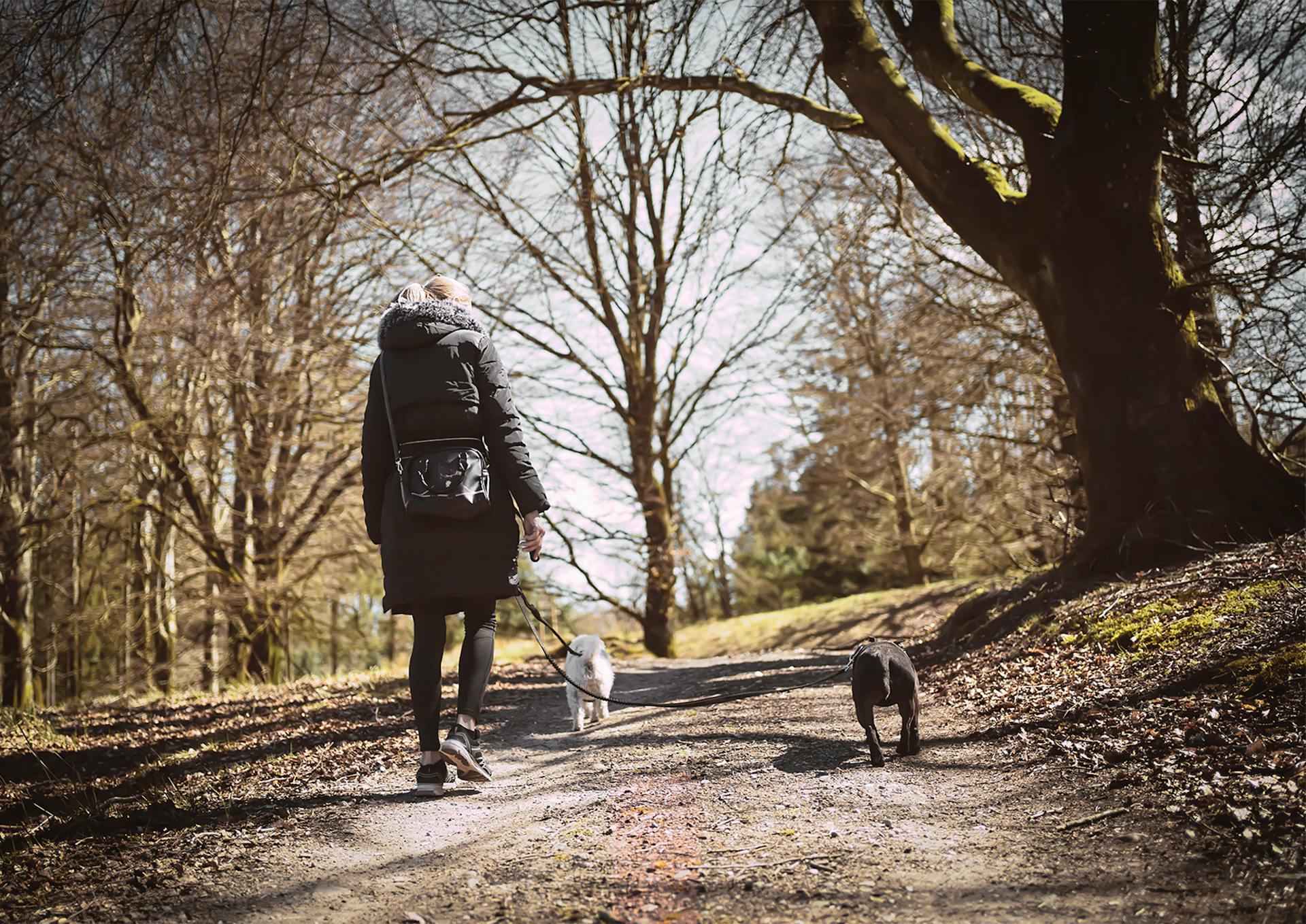
As a dog owner, it's natural to want to ensure your furry friend's health and well-being. One often-overlooked aspect of canine health is vision problems.
Some common signs of vision loss in dogs include stumbling or bumping into objects, difficulty navigating stairs, and an increase in anxiety or fear-based behaviors.
If you notice your dog having trouble seeing, it's essential to take action to keep them safe.
By being aware of the signs of vision loss and taking preventative measures, you can help your dog adapt to any visual impairments and maintain a happy, healthy life.
Signs of Vision Problems
Signs of Vision Problems can be subtle, but there are several indicators you should look out for. Squinting, eye discharge, and eye redness are all potential signs of eye problems in dogs.
If your dog's eyes appear cloudy or have a white spot, it could be a sign of cataracts or glaucoma. These conditions develop slowly over time, so it's essential to monitor your dog's eyes regularly.
Readers also liked: Why Does My Dogs Eyes Water
Some common behaviors to watch for include bumping into objects, pawing at the eye, and sudden changes in vision. If your dog is bumping into things frequently, it may be a sign that their vision is deteriorating.
Here are some behavioral changes to look out for:
- Changes in how your dog plays
- Difficulty finding food or eating less
- Increased clumsiness and tripping
- Dependence on you for navigation
- Getting startled easily
Keep an eye on these signs and consult with your veterinarian if you notice several of them at once. Early detection can make a big difference in your dog's quality of life.
Cloudy Appearance
A cloudy appearance in your dog's eyes can be a concerning sign of vision problems. This can manifest as a small white spot or a clouded veil over the eye, which is often associated with cataracts or glaucoma.
These conditions can develop slowly over time, so it's essential to monitor your dog's eyes regularly and take note of any changes. A comparison with old photos or images can help you spot any differences.
Explore further: Black Spot on Dog Tongue Labrador
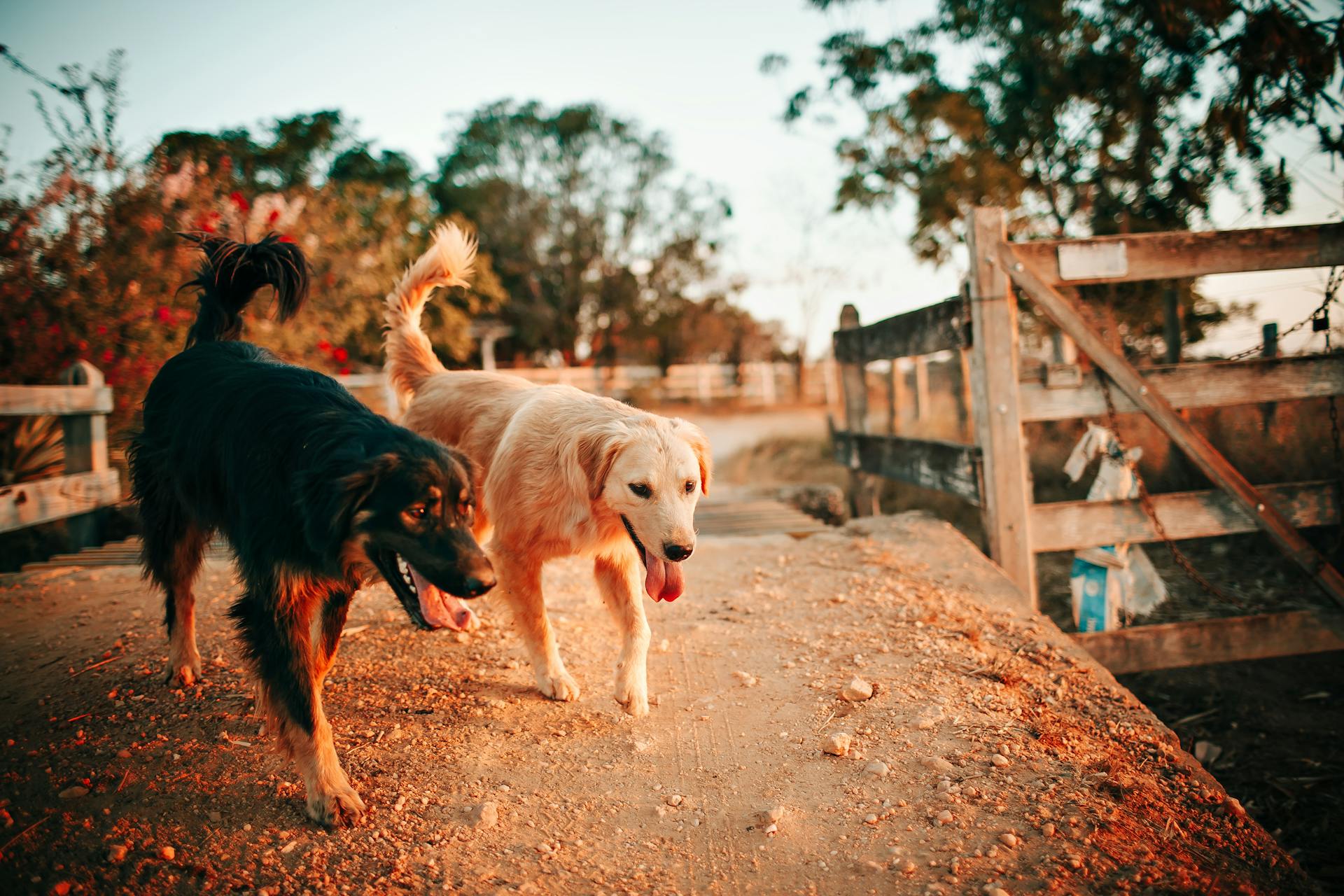
A cloudy appearance can also be accompanied by other symptoms, such as squinting, eye discharge, or eye redness. If you notice any of these signs, it's crucial to consult with your vet.
Here are some signs of cloudy appearance in your dog's eyes:
- Small white spots or a clouded veil over the eye
- Cataracts or glaucoma
Noticing Behavioral Changes
Your dog's behavior can be a strong indicator of vision problems. Changes in how your dog plays can offer clues regarding their vision. Sometimes, a lack of activity can be due to vision, not just a decline in interest.
Watch how your dog responds during play. If they seem hesitant or clumsy, it may be related to their vision. You may notice your dog bumping into things or having trouble navigating familiar spaces.
If your dog is suddenly eating less, it may be struggling to find its food. Keep an eye on your dog around its food and water bowl. If it's not being refilled as frequently, it could be a sign of vision problems.
Intriguing read: My Dogs Not Eating and Is Lethargic

Dogs who are losing their vision suddenly become clumsier. They may trip more often and bump into people and objects frequently. You may also notice your dog moving less overall and being hesitant to move around.
A loss of vision can cause anxiety, and your dog may become clingier. They may follow you around the house more and become increasingly agitated when you leave for work or school. You may notice your dog whining or howling when it sees you leave.
If your dog gets startled easily, it could be a sign of vision problems. They may nip or growl when startled, as they won't be able to see you coming.
Here are some behavioral changes to look out for:
- Changes in how your dog plays
- Sudden lack of interest in food
- Increased clumsiness and bumping into things
- Reduced mobility and hesitation to move around
- Increased clinginess and anxiety
- Startling easily and nipping or growling
Watery
Watery eyes, also known as epiphora, is a common issue in dogs.
Dogs develop epiphora due to excess tear production from eye irritation or a lack of drainage.
Eye irritation can be caused by allergies, trauma, or infection.
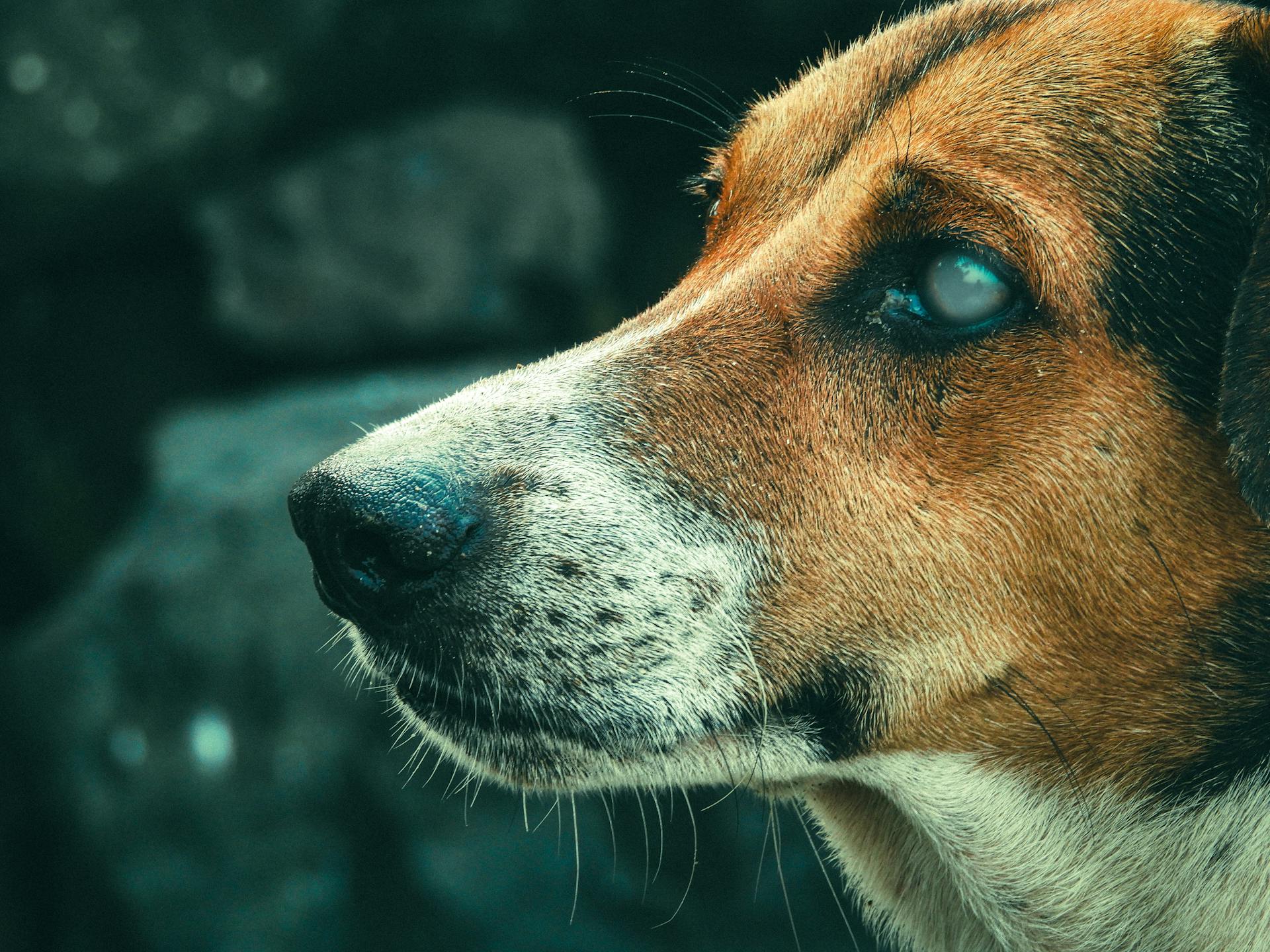
Tears from the eyes usually drain through the nasolacrimal duct into the nasal cavity.
But when drainage is obstructed or poor, tears run down a dog's face instead.
Clear tears and clear eyes are typically not considered a medical issue.
However, excessive tears with signs of eye irritation should be evaluated by a veterinarian.
A unique perspective: Female Dog Leaking Clear Odorless Fluid
Cataract or Glaucoma
Cataract or glaucoma can cause a dog's vision to decline, often affecting older dogs. These conditions can lead to clouding of the lens, sensitivity to light, and difficulty with night vision.
Clouding of the lens is a hallmark symptom of cataracts, which is the most common cause of blindness in dogs. In fact, cataracts can occur in many breeds, including the Afghan Hound, American Cocker Spaniel, and German Shepherd.
Diabetes, injuries, poor diet, and aging can also contribute to cataracts. If you notice these symptoms in your dog, it's essential to consult with your vet to plan treatment or surgery.
Expand your knowledge: Can a Bug Bite Cause a Lump on a Dog
Cataract surgery is a common procedure that can make a significant difference in your dog's quality of life. In fact, Dr. Lim notes that the surgery itself is not too stressful for most patients.
However, the first few weeks post-surgery can be challenging, as your dog will need to wear an Elizabethan collar at all times and follow a medication regimen.
Here are some signs that may indicate your dog is experiencing eye problems due to cataracts or glaucoma:
- Squinting
- Eye discharge (especially if it's not clear)
- Eye redness
- Cloudiness
- Pawing at the eye
- Sudden change in vision (bumping into things, anxiety, hesitation to walk)
- Swollen eyes
- Bulging eyes
- Persistently dilated or constricted pupils
Prevention and Support
Your vet is there to help with any concerns about your dog's eyesight, so don't be afraid to reach out for a consultation.
Regular check-ups with your vet can help identify potential eye problems early on. Just remember to call your vet right away if you notice any issues with your dog's pupils, eyelid, or blood pressure.
If this caught your attention, see: Vets Dog Treats
Blindness Prevention and Support
If you're worried about your dog's pupils, eyelid, blood pressure, or just have a general concern about their eyesight, call your vet right away and request a consultation.
Your vet is there to help, so don't be afraid to use them.
Regular check-ups with your vet can help identify any potential eye problems early on.
Don't wait until it's too late, your vet can provide guidance on how to prevent blindness in your dog.
Blind Maintenance

Regular walks are crucial for blind dogs, especially if they've become blind later in life, as they may not feel as inclined to move around.
You can try to avoid moving your furniture around so that your blind dog can feel confident at home.
Blind dogs can be kept mobile with plenty of sensory entertainment that stimulates their senses, such as toys designed specifically for them.
If a dog is born blind, they'll figure the world out in their own way, but if they start losing their sight when older, you may need to retrain them to navigate the world easier.
Just make sure they're happy, healthy, and active, and you'll be doing a great job as a pet owner.
Paying Attention to Changes
You want to catch any potential issues early on, so it's essential to pay attention to changes in your dog's behavior and physical condition.
Cloudy pupils can be a sign of age-related vision loss in dogs.
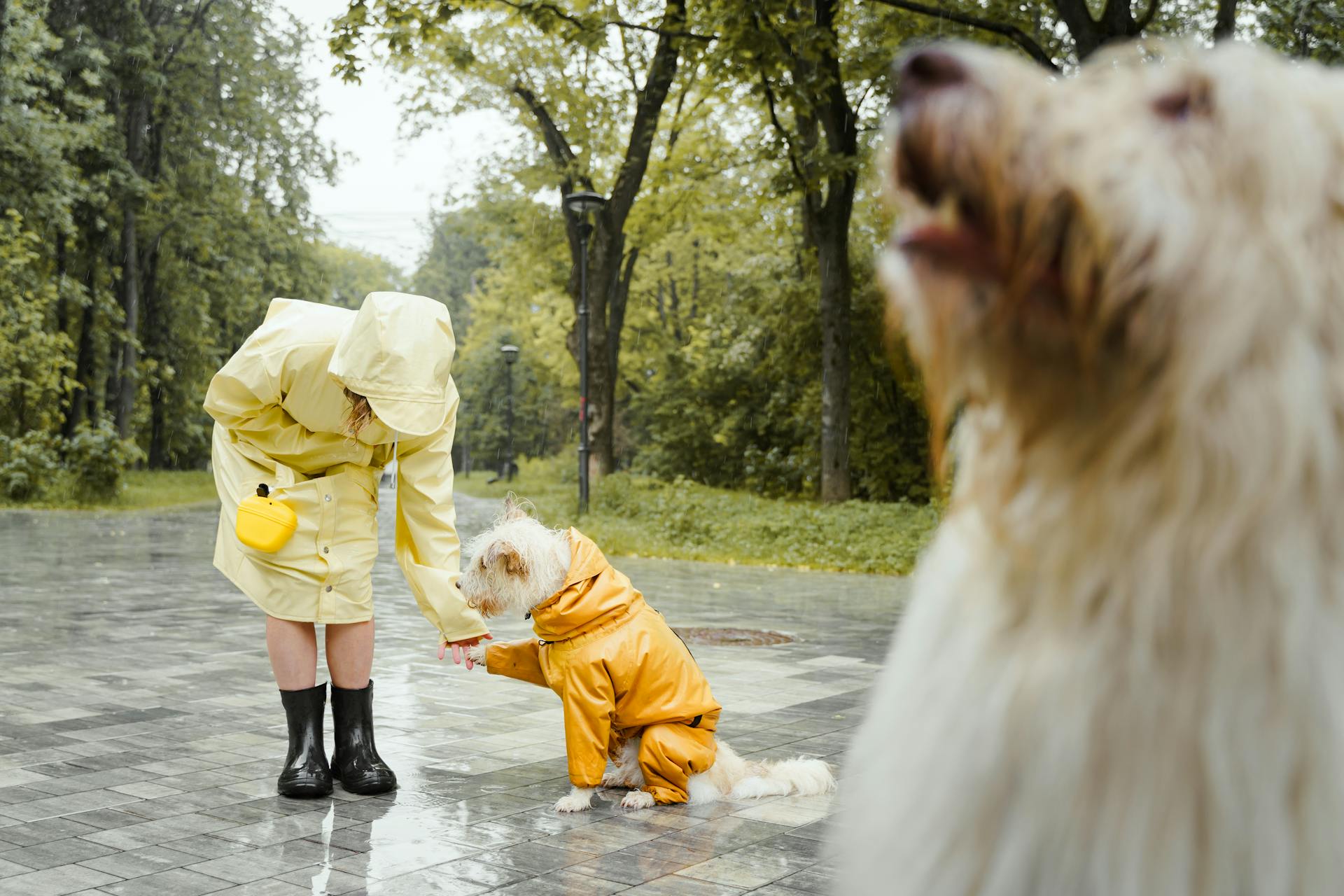
Changes in your dog's eyes can also be detected in pictures, especially if there's a greenish appearance in response to camera glare.
A tacky discharge in or around your dog's eyes may indicate dry eye, which can cause vision problems.
If your dog is having trouble seeing, it may lead to a decrease in appetite, as finding food becomes more challenging.
You may notice your dog eating less or having trouble finding its food bowl.
Dogs who are losing their vision often become clumsier and trip more often.
Mobility changes can be a clear indicator of vision loss in dogs.
If your dog is increasingly dependent on you, it may be a sign that its vision is declining.
You may notice your dog following you around the house more and becoming agitated when you leave.
Dogs who are losing their vision can get startled easily, which may lead to aggression.
Startle responses can be unpredictable and may result in nipping or growling.
Related reading: How to Tell If Your Dog Is Losing Hearing
Diagnosing Vision Problems
Diagnosing vision problems in dogs requires a keen eye for subtle changes in behavior and physical symptoms. If your dog is struggling with its eyesight, look out for signs like pawing at or scratching its eye, squinting, bumping into things, or being afraid of the dark.
These behaviors may not necessarily be connected to sight loss individually, but if you notice several signs at once, it's time to consult a veterinarian. A veterinary ophthalmologist, a specialist in animal eyes and their disorders, may be needed for a proper diagnosis.
Only about 300 veterinarians in the United States have board certification from the American College of Veterinary Ophthalmologists, so you may need to travel to see a specialist.
Refusal to Move Between Floors
Going up and down the stairs can be difficult enough for a dog, especially if they have short legs.
If your dog is unable to see where they're going due to sight loss, they're even less likely to want to risk the journey.
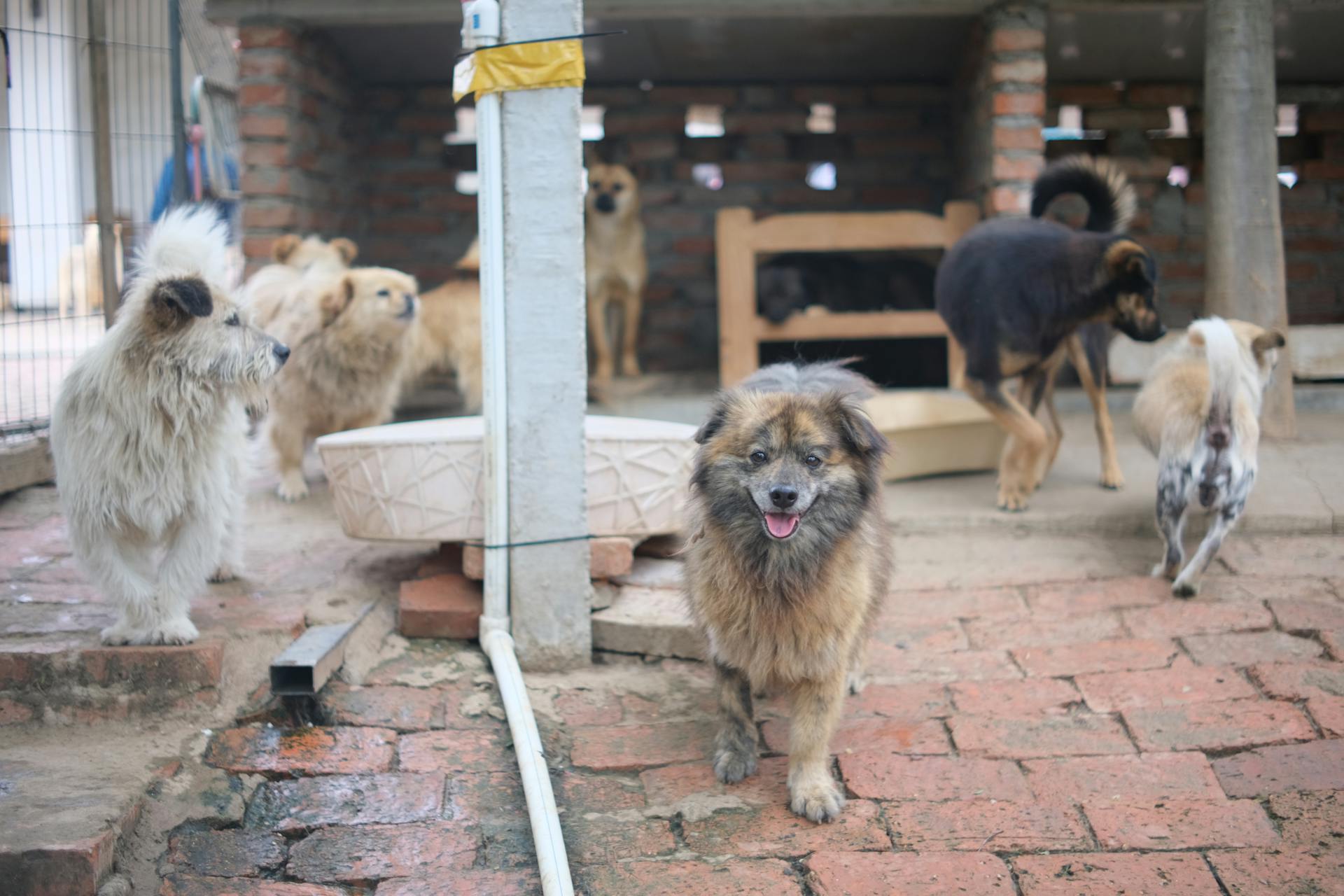
This behavior can be a sign that your dog is having trouble navigating stairs due to a vision problem.
Dogs with sight loss may be hesitant to move between floors because they can't see the stairs or the floor below them.
Their lack of confidence can make them reluctant to attempt the journey.
In some cases, your dog may even refuse to move between floors altogether.
Menace Reflex Test
If your dog is struggling with their eyesight, there are some telltale signs to look out for. These signs could help you identify if your dog is having trouble seeing.
The Menace Reflex Test is a simple at-home test that can help you check your dog's vision. You can do this test with your hand or a toy.
To do the test with your hand, hold it 18 inches away from your dog's eyes and move it quickly towards their face. Be careful not to get too close or move your hand too fast.
A different take: Canine Diabetes Testing
If your dog doesn't blink at all, or only blinks when you're within a few inches of their eyes, it may be a sign that they're struggling with their eyesight.
Alternatively, you can drop a toy from above your dog's head and check if they follow it as it falls. If their vision is healthy, they should be able to track the toy as it enters their line of sight.
If this caught your attention, see: Dogs Gums Bleeding When Chewing Toy
Treating Vision Problems
Treating Vision Problems can be a challenging and emotional experience for dog owners. If you suspect your dog is having vision problems, a vet can do a checkup, determine the level of vision loss, and recommend a treatment program.
Your vet may recommend surgery to reverse cataracts, which has a high success rate if your dog is currently in good health. This involves removing the cataract and placing an artificial lens in its place.
If your dog's loss of vision is irreversible, you can work to leave non-visual cues around your home to help your dog get around. This can include making sure your home is safe for your dog, removing hazards that it cannot see, and being patient as you adjust to your dog's medical condition.
To make your home safe for your dog, consider the following tips:
- Remove tripping hazards and obstacles
- Secure loose cords and wires
- Block off areas that your dog should not enter
- Use non-slip mats in areas where your dog may slip
Macular Degeneration
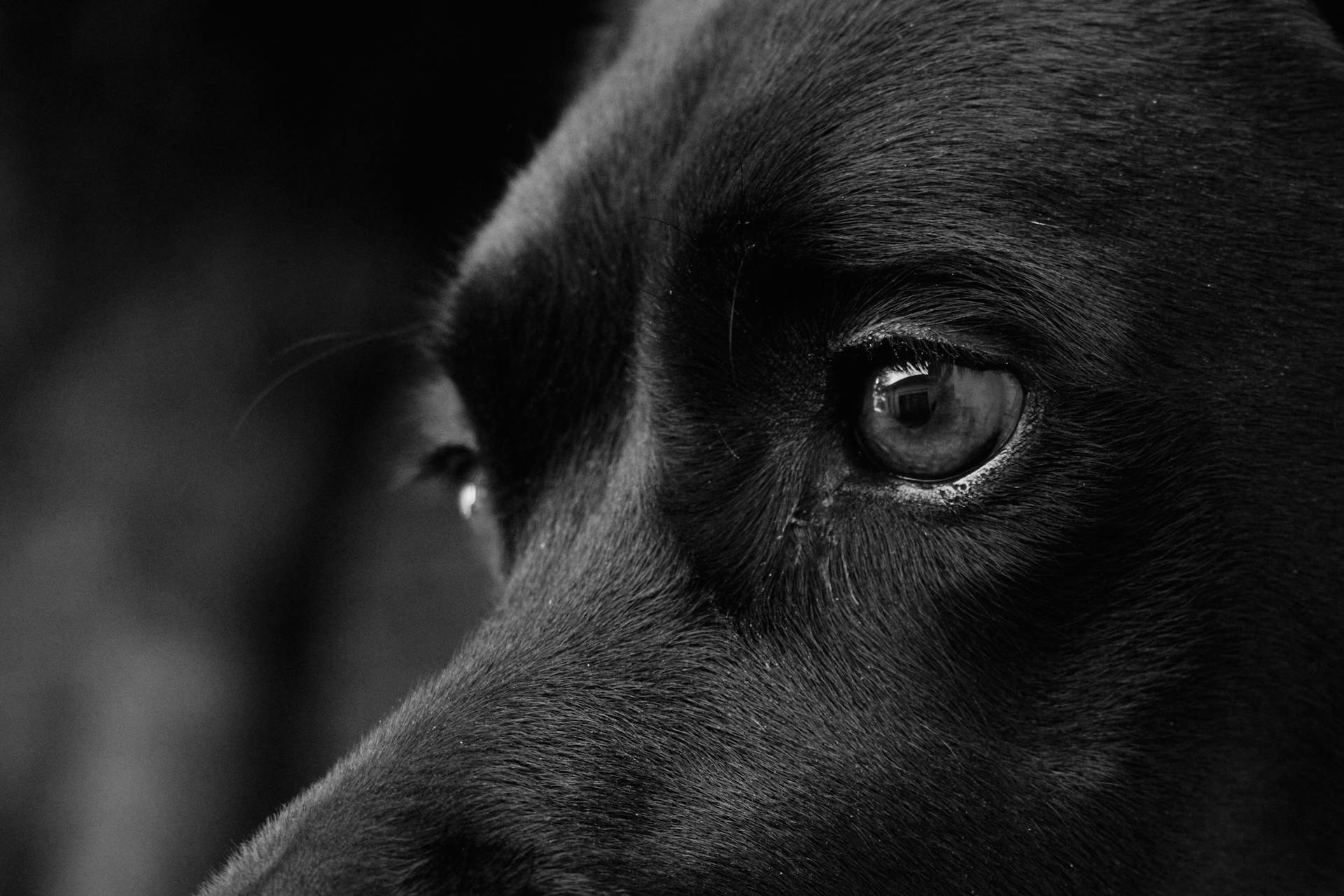
Macular Degeneration is a serious condition that affects a dog's ability to see details and colors.
The macula component of the retina is responsible for distinguishing detail and color, and when it's affected by macular degeneration, a dog's vision will become impaired.
This impairment affects both long-distance and short-distance vision, making everyday activities more challenging for the dog.
Macular degeneration is a disease that currently has no treatments, leaving owners with limited options for relief.
However, there is a recommended surgery that may be considered, although it's considered very risky.
Treating Problems
If your dog is experiencing vision problems, it's essential to visit your vet as soon as possible to address the issue. Changes in behavior and appearance should always be evaluated by a veterinarian.
A vet can do a checkup, determine the level of vision loss, and recommend a treatment program. This is the first step in treating your dog's vision problems.
If your dog has cataracts, surgery might be an option. This removes the cataract and places an artificial lens in its place.
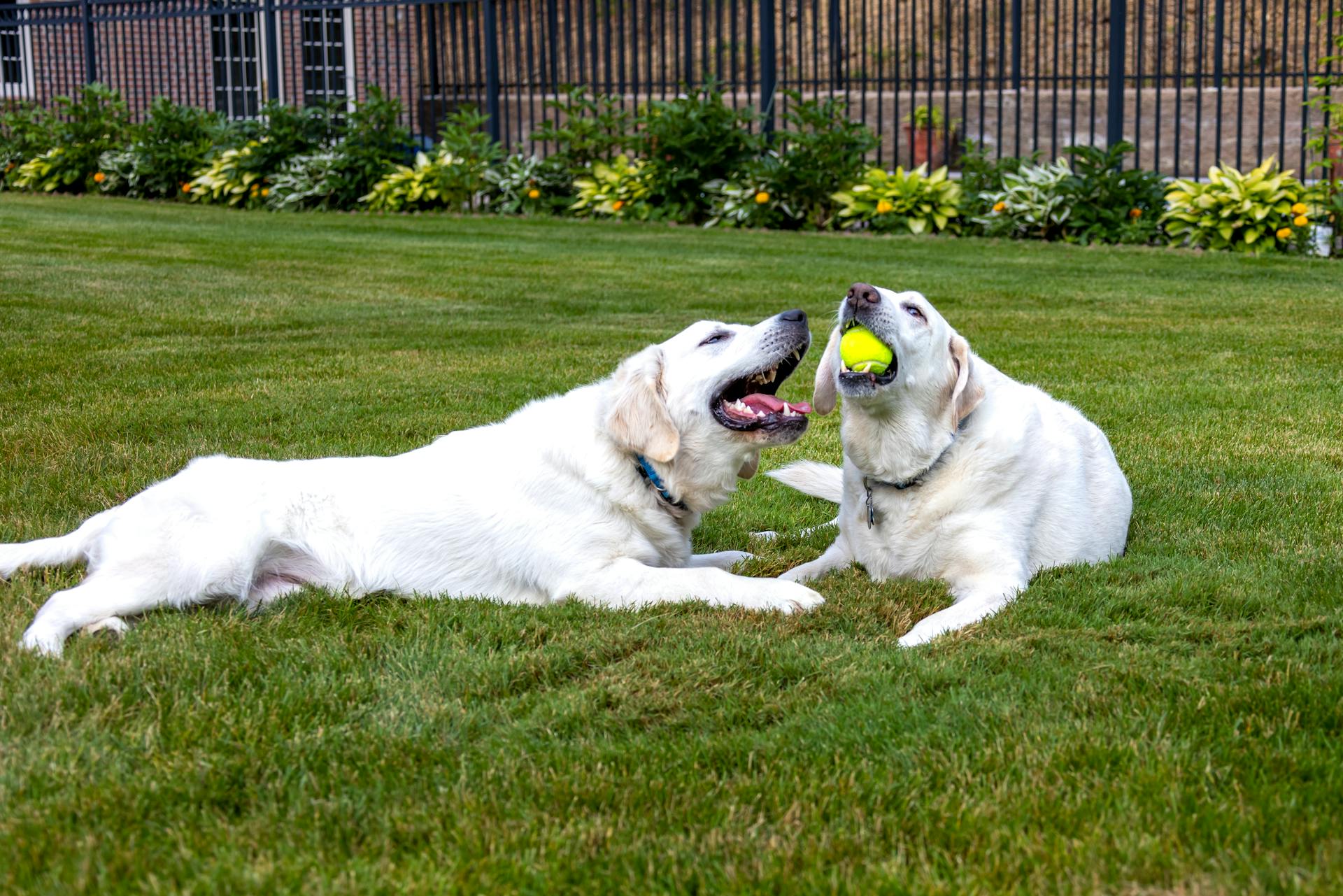
In some cases, there is no cure for canine blindness other than management. This means creating non-visual cues in your home to help your dog get around.
To make your home safe for your dog, you'll want to remove any hazards that it cannot see. This is especially important if your dog is going blind.
Here are some steps you can take to make your home safe for your dog:
- Secure any loose wires or cords
- Move any breakable objects to high shelves
- Block off any areas that are off-limits
Remember to have patience when adjusting to your dog's new vision. It can take time to make the necessary alterations to your home and schedule.
Frequently Asked Questions
How do you check a dog's vision?
Check your dog's vision by shining a bright light in a dark room and observing their reaction, as a lack of squinting or blinking may indicate vision issues. This simple test can help you identify potential vision problems in your furry friend.
What do a dog's eyes look like when they are going blind?
A dog's eyes may appear white, blue, or hazy as they lose their sight. If you notice changes in your dog's eye color, it could be a sign of underlying vision issues
Is vision loss reversible in dogs?
Unfortunately, vision loss in dogs is often irreversible, but there are steps you can take to help your dog adapt and live comfortably
Featured Images: pexels.com

